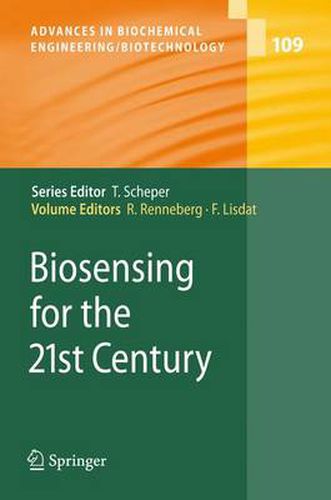Readings Newsletter
Become a Readings Member to make your shopping experience even easier.
Sign in or sign up for free!
You’re not far away from qualifying for FREE standard shipping within Australia
You’ve qualified for FREE standard shipping within Australia
The cart is loading…






This title is printed to order. This book may have been self-published. If so, we cannot guarantee the quality of the content. In the main most books will have gone through the editing process however some may not. We therefore suggest that you be aware of this before ordering this book. If in doubt check either the author or publisher’s details as we are unable to accept any returns unless they are faulty. Please contact us if you have any questions.
To detect, quantify, and model biologically signi?cant molecules is getting more and more important in our everyday life, in medicine, industry, and environment. When a group of enthusiasts like Frieder Scheller started more than 40 years ago to develop biosensors, they would not foresee that biosensors are nowavailableineverydrugstore,thatthehumangenomesequenceisavailable on the Internet, that DNA tests help in forensic cases, that we can track down thepathofourancestorsfromAfrica…This allis bioanalytics in practice! FriederSchellerisoneofthepioneersofthis?eld.So,wedidnothesitatefor longwhenThomasScheper,theSeriesEditor,askedustocompileamonograph th writtenbytheleadingspecialist tohonorhis65 birthday withafreshinsight into the ever expanding bioanalytical ?eld. Thanks to all contributors and thanks to the staff at Springer Verlag: Birgit Kollmar-Thoni, Ulrike Kreusel and Dr.Marion Hertel fortheir help! st Even in the 21 century biosensors will continue to play an important role in bioanalytics. By de?nition biosensors are characterized by a rather close contact of the biocomponent for recognition and the transducing element. Thus,thedevelopment ofbiosensors isahighlyinterdisziplanary ?eld.Future developments can be particularly seen in sensitivity enhancement down to the molecular level, switchability of the sensing device, miniaturization and integration into microsystems, incorporation of new transduction and ch- acterization methods and the use ofarti?cial recognition elements. This book tries to cover recent developments in order to illustrate the potential of thisrather fascinating area of science. Atthestartofthebook,youwill?ndachapteraboutthehistoryofbiosensors and Frieder Scheller’s contribution. It gives you an impression what this re- less,unsel?shandcreativescientisthasdone.Tounderlinethebasicbiosensor idea we start here with a cartoonabout Frieder Scheller’s work: XII Preface Aller guten Dinge sind drei ( ‘all good things are 3 , as Germans believe). They all may partly characterize Frieder: Chancefavorsonlythepreparedmind.
$9.00 standard shipping within Australia
FREE standard shipping within Australia for orders over $100.00
Express & International shipping calculated at checkout
This title is printed to order. This book may have been self-published. If so, we cannot guarantee the quality of the content. In the main most books will have gone through the editing process however some may not. We therefore suggest that you be aware of this before ordering this book. If in doubt check either the author or publisher’s details as we are unable to accept any returns unless they are faulty. Please contact us if you have any questions.
To detect, quantify, and model biologically signi?cant molecules is getting more and more important in our everyday life, in medicine, industry, and environment. When a group of enthusiasts like Frieder Scheller started more than 40 years ago to develop biosensors, they would not foresee that biosensors are nowavailableineverydrugstore,thatthehumangenomesequenceisavailable on the Internet, that DNA tests help in forensic cases, that we can track down thepathofourancestorsfromAfrica…This allis bioanalytics in practice! FriederSchellerisoneofthepioneersofthis?eld.So,wedidnothesitatefor longwhenThomasScheper,theSeriesEditor,askedustocompileamonograph th writtenbytheleadingspecialist tohonorhis65 birthday withafreshinsight into the ever expanding bioanalytical ?eld. Thanks to all contributors and thanks to the staff at Springer Verlag: Birgit Kollmar-Thoni, Ulrike Kreusel and Dr.Marion Hertel fortheir help! st Even in the 21 century biosensors will continue to play an important role in bioanalytics. By de?nition biosensors are characterized by a rather close contact of the biocomponent for recognition and the transducing element. Thus,thedevelopment ofbiosensors isahighlyinterdisziplanary ?eld.Future developments can be particularly seen in sensitivity enhancement down to the molecular level, switchability of the sensing device, miniaturization and integration into microsystems, incorporation of new transduction and ch- acterization methods and the use ofarti?cial recognition elements. This book tries to cover recent developments in order to illustrate the potential of thisrather fascinating area of science. Atthestartofthebook,youwill?ndachapteraboutthehistoryofbiosensors and Frieder Scheller’s contribution. It gives you an impression what this re- less,unsel?shandcreativescientisthasdone.Tounderlinethebasicbiosensor idea we start here with a cartoonabout Frieder Scheller’s work: XII Preface Aller guten Dinge sind drei ( ‘all good things are 3 , as Germans believe). They all may partly characterize Frieder: Chancefavorsonlythepreparedmind.